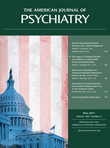Psychosurgery has had a very checkered history in psychiatry. In the 1930s, Egas Moniz (a neurologist) and Almeida Lima (a neurosurgeon) introduced prefrontal ablations in patients with severe psychiatric illness (
1,
2). Subsequently, Walter Freeman, a neurologist and psychiatrist without surgical training, performed the first prefrontal lobotomy in the United States. Over the next two decades, it is estimated that over 20,000 psychosurgeries were performed in the United States. The crude nature of the procedure, the lack of evidence of efficacy, the substantially blunted affect, and other adverse events led to its decline and essential discontinuation. This history has cast a large shadow over the development of neurosurgical interventions for psychiatric illnesses.
Nonetheless, in recent years several experimental neurosurgical procedures have been tried for severe intractable psychiatric disorders. Unlike in the past, these new surgeries are performed by well-trained neurosurgeons working with psychiatrists in first-rate academic medical centers. Several of these procedures include targeted ablations such as anterior capsulotomy, anterior cingulotomy, and subcaudate tractotomy (
2). An alternative to ablation procedures is intracranial electrical stimulation of targeted areas of the brain, or deep brain stimulation (DBS). This involves stereotactical implantation of intracranial electrodes that are connected to an implanted impulse generator in the chest wall (
3). Advantages of DBS over lesioning include potential reversibility, revisability, and adjustability.
Research on the efficacy and safety of DBS for treatment-resistant depression has been limited to small open-label studies and case reports (
3). The largest study to date involves 20 patients at several academic centers who received 6 months of DBS to the subcallosal cingulate gyrus (Brodmann's area 25) (
4). To qualify for the study, patients had to be in an episode of major depression for at least 1 year and had to have failed to respond to at least four different treatments (including antidepressant, psychotherapy, and ECT) (
4). The initial 6-month response in these patients was 60%, and the remission rate was 30%. An article in this issue by Kennedy and colleagues (
5) describes an extended follow-up (mean duration, 3.5 years) of these patients. The long-term outcome of these severely ill patients is encouraging. The average response rate at the last follow-up visit was 64%, and the remission rate was 35%. Psychosocial functioning and physical health had improved substantially over time, and there were no significant DBS-related adverse events.
Why are these results encouraging? Because the clinical course of treatment-resistant depression is pernicious and pervasive. A recent review of the world's literature on treatment-resistant depression identified nine well-conducted longer-term outcome studies (
6). They found low remission rates (under 20%) and high relapse rates (over 80%) despite very aggressive treatment. Quality of life is poor, and psychosocial functioning is badly impaired.
DBS and ablative psychosurgery are strategies for patients with the most severe and intractable illness. What approaches are available to other patients? Pharmacologic treatments for treatment-resistant depression include selective serotonin reuptake inhibitors and heterocyclics, other antidepressants (such as bupropion and serotonin-norepinephrine reuptake inhibitors, mood stabilizers, and dopamine agents), in addition to a number of experimental agents, such as pindolol, inositol, stimulants, and omega-3 fatty acids (
7). Nonpharmacologic treatment strategies include psychotherapy, ECT, vagus nerve stimulation, and repetitive transcranial magnetic stimulation. Response and remission rates are substantially below those of standard treatments for non-treatment-resistant depression.
One issue arising from this study requires special attention—that of suicide. Two of the 20 patients in this extended follow-up study committed suicide, and two others made suicide attempts (
5). There is no evidence suggesting that DBS was related to these deaths. Rather, these suicides reflect the severity and seriousness of treatment-resistant depression. In one of these patients there had been periods of sustained remission, but the patient relapsed and required a course of ECT prior to her suicide. The other patient had persistent suicidal ideation.
These results underscore the high mortality in patients with treatment-resistant depression, even with careful and frequent monitoring by experienced and competent providers. It should serve as an impetus for us to continue to strive to develop new strategies to treat this patient population.

